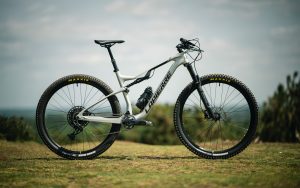For the XRM 6.9, Lapierre takes the full carbon frame from its World Cup XC bike, the XR, adds a longer travel fork, a dropper post and slightly burlier components, and hey presto, Lapierre has a marathon/down country bike. But has it worked? Before we answer that, let’s take a closer look at the details. Frame travel on the XRM is quoted at 110mm, but we measured it at 95mm, which is an alarmingly big discrepancy. It used a flex stay design to save weight where the carbon back end is big and burly, the wide main pivot stance and deep chainstays providing ample stiffness. The front end comes in four frame sizes, S to XL and the standover height is really good for what is essentially a hopped up XC bike. In terms of reach, the Lapierre is conservative: 458mm on the size L, favouring longer 70mm stems on the L and XL to get the right fit, rather than adding length to the frame and reducing the stem lengths. It seems to work pretty well here though, as the overall fit felt really good. Thankfully the angles are less reserved, the 65.8º head angle providing a predictable steering response, while the 74.6º seat angle stretches out the cockpit and works well with the shorter front end. Best cross-country XC mountain bikes: hardtail and full-suspension Uniting the carbon front and rear end is a short alloy linkage and shock yoke; where a co-pivot design connects both to the top of the seat stays. Again, just like the flex stay rear end, this means fewer pivots, bearings and hardware and equates to less weight, so all in the XRM 6.9 is a scant 13.19kg (29.08lb). Other neat features include a removable rear axle lever with a bottle opener, internal cable routing and a 100mm dropper post that puts the saddle securely between your thighs when descending, so you still have some control over the bike, handy given how light it is. Suspension With the 50mm stroke RockShox SID Luxe shock promising 110mm but delivering 95mm of travel, the Lapierre has a very low leverage ratio. So low in fact, when you combine it with the extra spring force required to compress the carbon flex stays, at 80kg, we were only running 125psi in the shock to achieve the desired 25% sag. Those are just numbers though, and out on the trail we were still able to use all of the travel with regularity. Best mountain bike forks: XC, trail and enduro forks reviewed If you’re new to the SID Luxe shock, it’s worth knowing that the rebound dial is a 2.5mm Allen key head hidden inside the compression dial, in this instance a lock out remote, and if you didn’t know it was there you could easily overlook it. We only used one third of the available rebound damping, so there’s plenty of scope to accommodate lighter or heavier riders. There’s no such setup issues with the RockShox SID 35 … Continue reading Lapierre XRM 6.9 review
